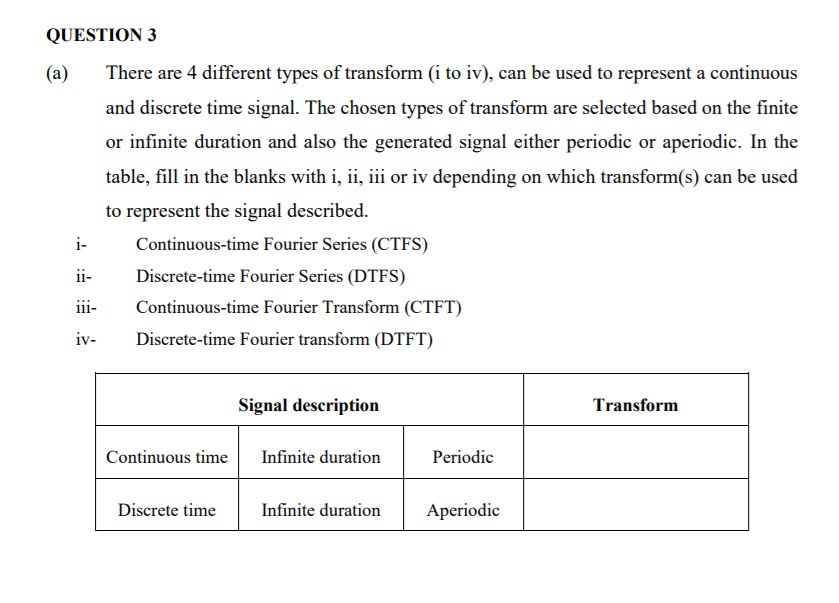QUESTION 3 (a) There are 4 different types of transform (i to iv), can be used to represent a continuous and discrete time signal. The chosen types of transform are selected based on the finite or infinite duration and also the generated signal either periodic or aperiodic. In the table, fill in the blanks with i, ii, ii or iv depending on which transform(s) can be used to represent the signal described. i- Continuous-time Fourier Series (CTFS) ii- Discrete-time Fourier Series (DTFS) ii- Continuous-time Fourier Transform (CTFT) iv- Discrete-time Fourier transform (DTFT) Signal description Transform Continuous time Infinite duration Periodic Discrete time Infinite duration Aperiodic
QUESTION 3 (a) There are 4 different types of transform (i to iv), can be used to represent a continuous and discrete time signal. The chosen types of transform are selected based on the finite or infinite duration and also the generated signal either periodic or aperiodic. In the table, fill in the blanks with i, ii, ii or iv depending on which transform(s) can be used to represent the signal described. i- Continuous-time Fourier Series (CTFS) ii- Discrete-time Fourier Series (DTFS) ii- Continuous-time Fourier Transform (CTFT) iv- Discrete-time Fourier transform (DTFT) Signal description Transform Continuous time Infinite duration Periodic Discrete time Infinite duration Aperiodic
Introductory Circuit Analysis (13th Edition)
13th Edition
ISBN:9780133923605
Author:Robert L. Boylestad
Publisher:Robert L. Boylestad
Chapter1: Introduction
Section: Chapter Questions
Problem 1P: Visit your local library (at school or home) and describe the extent to which it provides literature...
Related questions
Question

Transcribed Image Text:QUESTION 3
(a)
There are 4 different types of transform (i to iv), can be used to represent a continuous
and discrete time signal. The chosen types of transform are selected based on the finite
or infinite duration and also the generated signal either periodic or aperiodic. In the
table, fill in the blanks with i, ii, iii or iv depending on which transform(s) can be used
to represent the signal described.
i-
Continuous-time Fourier Series (CTFS)
ii-
Discrete-time Fourier Series (DTFS)
iii-
Continuous-time Fourier Transform (CTFT)
iv-
Discrete-time Fourier transform (DTFT)
Signal description
Transform
Continuous time
Infinite duration
Periodic
Discrete time
Infinite duration
Aperiodic
Expert Solution
This question has been solved!
Explore an expertly crafted, step-by-step solution for a thorough understanding of key concepts.
Step by step
Solved in 2 steps with 2 images

Knowledge Booster
Learn more about
Need a deep-dive on the concept behind this application? Look no further. Learn more about this topic, electrical-engineering and related others by exploring similar questions and additional content below.Recommended textbooks for you

Introductory Circuit Analysis (13th Edition)
Electrical Engineering
ISBN:
9780133923605
Author:
Robert L. Boylestad
Publisher:
PEARSON

Delmar's Standard Textbook Of Electricity
Electrical Engineering
ISBN:
9781337900348
Author:
Stephen L. Herman
Publisher:
Cengage Learning

Programmable Logic Controllers
Electrical Engineering
ISBN:
9780073373843
Author:
Frank D. Petruzella
Publisher:
McGraw-Hill Education

Introductory Circuit Analysis (13th Edition)
Electrical Engineering
ISBN:
9780133923605
Author:
Robert L. Boylestad
Publisher:
PEARSON

Delmar's Standard Textbook Of Electricity
Electrical Engineering
ISBN:
9781337900348
Author:
Stephen L. Herman
Publisher:
Cengage Learning

Programmable Logic Controllers
Electrical Engineering
ISBN:
9780073373843
Author:
Frank D. Petruzella
Publisher:
McGraw-Hill Education

Fundamentals of Electric Circuits
Electrical Engineering
ISBN:
9780078028229
Author:
Charles K Alexander, Matthew Sadiku
Publisher:
McGraw-Hill Education

Electric Circuits. (11th Edition)
Electrical Engineering
ISBN:
9780134746968
Author:
James W. Nilsson, Susan Riedel
Publisher:
PEARSON

Engineering Electromagnetics
Electrical Engineering
ISBN:
9780078028151
Author:
Hayt, William H. (william Hart), Jr, BUCK, John A.
Publisher:
Mcgraw-hill Education,